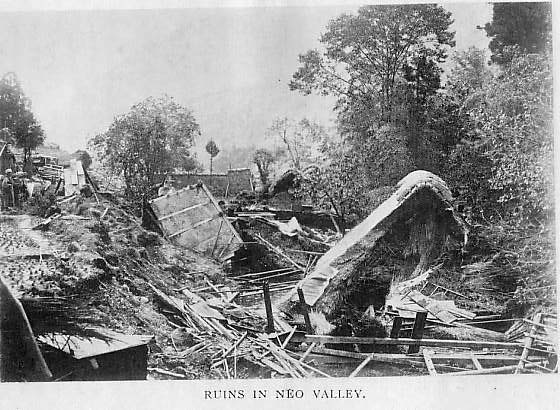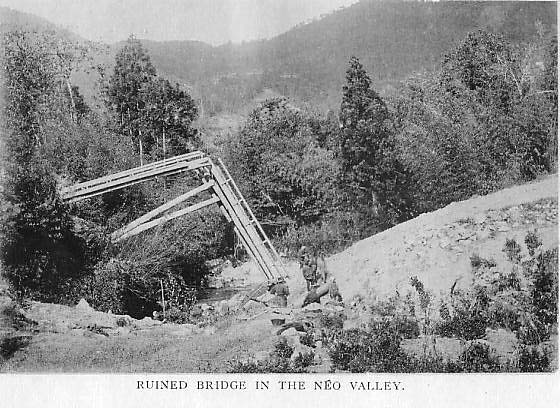The Great Japan Earthquake
Tokyo, 2nd February 1892
Bit by bit during the last three months there have come to light some more exact particulars of the great earthquake of the 28th of October than could be given when I wrote to you directly after its occurence.
These show, among other things, that the magnitude of the catastrophe was at first a good deal underestimated, in nearly every respect.
The number of people killed and burned to death, for instance, is now found to have been about 10,000 instead of 8,000, and the number of the injured to have been 15,000 instead of 10,000.
The area of the severely shaken district - taking as its measure that in which brick buildings suffered - is estimated by Professor Milne, in a recent monograph on the subject, at 4,400 square miles.
The same authority adds that the disturbance distinctly shook about 92,000 square miles of Japan's territory; that tremors were noticed at Shanghai; that delicate instruments may possibly have been affected even at our antipodes; and that, if Japan had been surrounded by terra-firma instead of water, the land-area directly agitated would have been as many as 400,000 square miles.
It is now certain that the focus of most potent energy was in the Mino mountains, to the north of Gifu, as suggested in my former letter.
The Neo Valley in that region, happily containing but few inhabitants, presented to the bewildered gaze of the half-dozen adventurous spirits who hurriedly visited it soon after the disaster a scene of past havoc so tremendous and terrible as to have changed almost the whole face of nature.
Unfortunately, the circumstances of the time and the difficulty and danger of travel forbade any thorough examination of the valley and its environs.
Explorers, however bold and ardent, could hardly be expected to stay long enough for that purpose in a region where the still palsied earth kept groaning and quaking under their feet, and where the shattered hill-sides over which they had to scramble were from time to time breaking away, with a deafening roar, in stupendous landslips, themselves great enough to produce local earthquakes on a small-scale.
A little later the first snow of winter fell, and blocked the upland glens.
Deliberate research was thus prevented, and cannot be undertaken before the coming spring.
Enough, however, was observed by the early explorers to establish that the chief lines of destructive agency converged towards some quarter of the hill-region in or near this Neo Valley, and that the surface convulsions thereabouts must have been of almost inconceivable violence.
At some points, indeed, upheaval and depression had wrought abrupt changes of the ground-level amounting to as many as 50 feet.
By the peasantry it was even said that the neighbouring mountains had here and there subsided bodily, thereby opening-up to view from certain points remoter peaks that had been before invisible.
Without doubt, then, this whole district will well repay further investigation, as that in which they earthquake forces exerted their greatest energy.
Meantime, it is hardly to be supposed that efforts so gigantic as to have set the earths' crust in motion over a region greater than the Empire of Japan can have resulted from an underground expolsion at any small volcanic centrum.
We must rather believe, as Mr. Milne suggests, that they proceeded from some very powerful cause operating over a large subterranean area.
Among the causes, apart from volcanic efforts, that may be regarded as instrumental in producing seimic disturbances, interruptions of the general process of secular elevation or subsidence of the land or the ocean floor are mentioned by Mr. Milne.
Just as conditions of delicate equilibrium may be brought about by a balance of subterranean steam pressure and rock resistance, so may they be brought about by a balance between the elasticity of rock masses and forces opposed thereto.
Any cause that serves to destory this delicate balance - as, for example, such comparatively slight agencies as periodical barometric fluctuations, the influence of the moon when in perigee and possibly even some special meteorological conditions, or states of atmospheric electricity-may result in a sudden yielding of extensive rocky masses, the jar thereof creating primary earthquake shocks, while the after-shocks result from the gradual settlement of disjointed strata.
Plainly, if this be true, systematic observations directed at determining slow changes in the level of the land might be of service towards the solution, in part, of the probllem of forecasting earthquake disturbances.
They might also, Mr.Milne points out, throw light upon the mysterious movements that are found to affect the piers of astronomical instruments, as well as on the perplexing results sometimes encountered in geodesic operations.
As to the exact nature of the cause of the great earthquake under discussion, expert opinion has not yet been clearly declared.
Geologically, the beautiful and garden-like Nagoya plain - supporting a population of, perhaps, 800 to the square mile - that was so terribly devastated three months ago is, according to Professor Milne, a bed of alluvium lying in a basin of Palaeozic hills; and it is in the northern quarter of those hills that the disturbance had its origin, there generating and sending forth the wave-like movements of the ground which disported themselves so freely in the soft alluvium of the adjacent plain as to wreck towns and villages, bring death or injury to 25,000 people, streak the face of the land with fissures, and shatter the strongest enginneering structures.
There are, however, neither volcanoes nor volcanic rocks in that section of the country, nor is the district at all near to any of the three great lines of volcanic weakness which travers other parts of the empire..
Earthquakes, on the other hand, are tolerably frequent.
There has been on the whole, as I said in my first letter on this subject, a marked falling-off of seimic activity in the Mino-Owari region generally during the last 1,000 years.
Not, however, without interruptions at long intervals.
In 1826, 1827, and again in 1859, for example, severe disturbances were experienced in the Gifu district.
It has been found, also, from modern records at earthquake-observing stations in the plain, that the number of the shocks there per annum, which was only four in 1886, jumped from, 15 in 1889 to 36 in 1890.
In one locality, Mr. Milne adds, near to the centre of the late disturbance, 19 shocks were observed in 1888, and a point of weaknes was indicated.
The above degrees and variations of frequency were, nevertheless, small in comparison with the constantly observed phenomena at other places in Japan.
In this capital, for instance, we had 51 shocks in 1885, 115 in 1889, and 93 in 1890.
Changes of activity, in fact, and points of seimic weakness, declare themselves so often in this very unstable domain of the earth's crust that, as far as previous experience went, the numerical increase of slight earthquakes in the Nagoya-Gifu district between 1885 and 1890 could hardly be said to afford grounds for special apprehension.
But the importance of regarding carefully all such indications has now been established by the terrible lesson of last October; and Japan, with her 700 earthquake-obeserving stations scattered over the empire, is well equipped for profiting by that lesson.
That she sorely needs to pay close heed to all that observation and research can teach her is established by ages of bitter experience.
Not only are her people shaken up by fully 500 earthquakes every year - some of them more or less destructive - but at intervals there comes a great disaster, amounting, as in the present case, to a national calamity.
No fewer than 29 of such disasters have been recorded in Japanese annals during the last 1,200 years.


The Times; - Not appeared
Going Back to Article List
